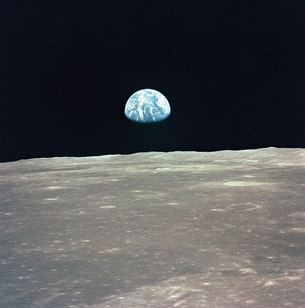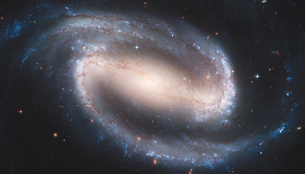Module 4—Gravitational Force
 Big Picture
Big Picture

Image courtesy of the Image Science & Analysis Laboratory, NASA Johnson Space Center
Have you ever considered using the Moon, planets, and stars as part of your playground? In many ways, Homo sapiens have been imagining this for centuries. The reality is much more recent. The picture to the right shows Earth rising over the Moon's horizon. It was taken from the Apollo 11 spacecraft. Humanity stretched its playground by about 385 000 km, and men walked on the Moon’s surface on July 20, 1969. Does anyone in your family remember what they were doing that day? Check with your family and friends’ families to see how humanity’s view of the world and space were changed by that event. The last manned trip to the Moon took place three years later. Since then, the exploration of the solar system and the universe has taken place either closer to home or by using remotely controlled spacecraft.

Image Courtesy of NASA, ESA, and The Hubble Heritage Team (STScI/AURA)
One of these spacecraft, the Hubble Space Telescope, took the image to the left in 2004. This spectacular image is of Barred Spiral Galaxy NGC 1300. NGC 1300 is 69 million light-years away and is 110 000 light-years wide. The universe is one mighty big playground.
Can you imagine the knowledge needed to successfully launch a spacecraft and land it on the Moon or the knowledge needed to explain the shape and movement of NGC 1300?
You are about to look at the foundations of that knowledge, and again it begins with Isaac Newton and his discoveries in mathematics and science. In Module 4 you will learn about Newton's law of universal gravitation and the ways in which it explains the universe. In this module you will be exploring the following question: What role do gravitational effects play in the universe?
As you work through Module 4, keep the following essential questions in mind:
- How does gravity vary relative to distance between objects?
- How are weight and mass different?
- How are weight and the force of gravity related?
- How does gravity affect planets, moons, and other objects in the solar system?
- What does the law of universal gravitation tell you about gravity?
- Is the force of gravity a constant?
- How do scientists calculate weight on other planetary objects, such as the Moon?
- How does the law of universal gravitation explain the motion of orbiting bodies?
- How can you calculate the mass of Earth?
These questions should help you fit your world into our amazing universe and the physics that helps explain it all.
In addition to your lesson work you will have a module assessment to complete. For more information about the module assessment and evaluation criteria, go to the Module Assessment section of In This Module.